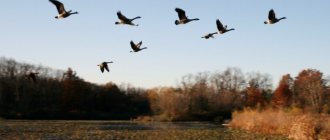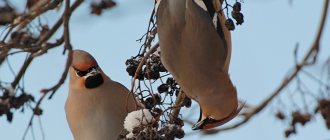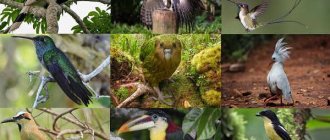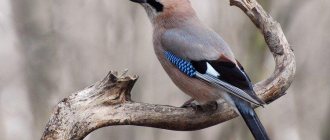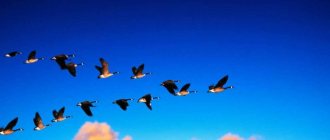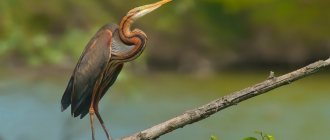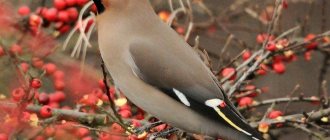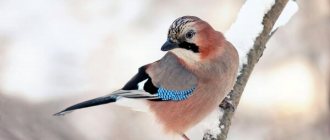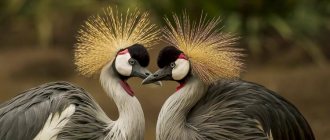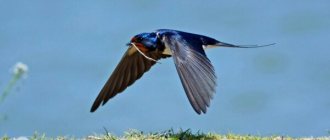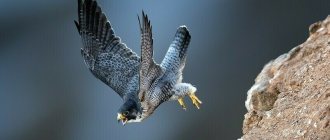Wonderful pictures with migratory and wintering birds. Which birds remain to spend the winter in their homeland, and which ones fly away?
Walking through a park or forest, we listen to birds singing and often simply don’t think about which bird trills so nicely. There are birds that live in our area all year round, but there are also those that fly to “warmer climes” in the fall.
Wild ducks in the sky
The fact is that in winter it is very difficult for birds to find food for themselves, because insects, berries and grains become scarce, and when snow falls, it is almost impossible to find them at all. And different species of birds solve this problem in different ways: migratory birds fly hundreds and even thousands of kilometers to warmer countries, while sedentary birds adapt to our harsh winters.
A tit in the snow, which apparently wants to eat some seeds
Settled, wintering birds: list, photos with names
To help the birds that remain over the winter find food, feeders are hung. And it is quite possible that they will be of interest to the following visitors:
- Sparrow . Noisy sparrows that fly in flocks may well become the first visitors to the feeder.
flock of sparrows
- Tit. Tits are in many ways not inferior to sparrows; they quickly rush to feed in feeders. But compared to sparrows, tits are endowed with a more gentle disposition. Interestingly, in the summer the tit eats almost as much food as it weighs. You can often see mixed flocks of both sparrows and tits at feeders.
Tit with a piece of bread Sparrows and tit
- Gaichka . A close relative of the tit. However, the chickadee's breast is not yellow, but light brown. The chickadee also differs from other tits in that it makes a hollow in a tree to make a nest in it.
The chickadee is a special type of tit
- Crow. Ravens are often confused with rooks. It is known that in the western part of Russia crows are very rare. Therefore, if you live in the European part of Russia and see a black bird emitting a piercing croak, then most likely it is a rook.
Black Crow
- Pigeon. The distribution and lifestyle of pigeons was largely influenced by people who simply brought them with them to different parts of the Earth. Now pigeons are found on all continents except Antarctica. Pigeons easily exchange rocks, which are their natural habitat, for man-made structures.
The nodding gait of pigeons is due to the fact that this makes it easier for them to examine the object of interest to them.
- Woodpecker. In the warm season, woodpeckers feed mainly on insects, which they get from under the bark of trees, and in the cold winter, they can also feed on plant foods: seeds and nuts.
Woodpeckers love to eat seeds from pine and spruce cones.
- Magpie. The magpie is considered a bird of high intelligence; it is capable of expressing a lot of emotions, including sadness, and can recognize its reflection in the mirror. It is interesting that not only its fellow birds react to the alarming cry of a magpie, but also other birds, as well as wild animals, in particular bears and wolves.
Magpie - wintering bird
- Owl . Owls come in different varieties, large and small, and there are more than 200 species in total. These birds are endowed with acute vision and excellent hearing, which allows them to lead a nocturnal lifestyle. It is interesting that the tufts on the owl's head are not ears, the real ears of owls are hidden in the feathers, and one of them is directed upward, and the other downwards, in order to better hear what is happening above the head and on the ground.
Owl is a night bird
- Owl. This bird is also considered an owl and is a close relative of other owls.
Owl
- Tawny owl. A rare owl that lives mainly in mountainous areas in northern latitudes. The name of the bird, according to different versions, means “inedible” or “insatiable.”
Tawny Owl
- Jackdaw. Externally, jackdaws are similar to rooks and crows; moreover, there are mixed flocks in which all three species of birds can be seen. However, the jackdaw is smaller in size than the crow. And if you are lucky enough to observe a jackdaw up close, you can easily recognize it by the gray color of some of its feathers.
Jackdaws really like shiny objects
- Nuthatch. This little bird climbs tree trunks very deftly. In summer, nuthatches hide seeds and nuts in the bark, and in winter they feed on these supplies.
Nuthatch on a birch tree
- Crossbill. Like the nuthatch, this bird is excellent at climbing trees and can hang upside down on branches. Crossbill's favorite food is seeds from spruce and pine cones. This bird is remarkable in that it can hatch chicks even in winter, but only if there is enough food.
Crossbill on spruce branches
- Bullfinch. Only males have bright red plumage on the chest; females look much more modest. Bullfinches are more often seen in winter, because due to lack of food, they are drawn to people. In summer, bullfinches prefer wooded areas and behave inconspicuously, so they are not easy to see.
Pair of bullfinches
- Waxwing . A bird with beautiful plumage and a singing voice. In summer it feeds mainly on insects and likes to settle in coniferous forests. In winter, the waxwing moves to more southern regions of the country and is often found in cities. In the cold season, rowan and other fruits become the main food for birds.
Waxwing on a rowan branch in winter
- Jay. A large bird, which, however, can fly to feast on a feeder hung by people. In the summer it is rarely seen in the city, but closer to winter the bird begins to reach out to human habitation.
Jay in winter
- Kinglet. One of the smallest birds, the weight of an adult male is only 5-7 grams. Kinglets are relatives of sparrows.
Kinglet - forest dweller
- Pheasant . A large bird that is a favorite trophy for many hunters. Pheasants can fly, but most often move on foot.
Pheasant
- Hazel grouse . It is also an object of hunting, despite the fact that this bird is quite small. The weight of an adult hazel grouse rarely reaches 500 g. Interestingly, the largest population of these birds lives in Russia.
The hazel grouse is a bird that is related to the black grouse
- Black grouse. Another bird that is related to hunting. Black grouse are found at the edge of the forest and in the forest-steppe.
Grouse
- Sokol . It is considered one of the smartest birds on the planet and one of the best hunters. The falcon is capable of working in tandem with a person, but it is very difficult to tame it.
Falcon in flight
- Hawk . Like the falcon, it is a bird of prey. A hawk's vision is 8 times sharper than a human's. And rushing after prey, the hawk can reach speeds of up to 240 km/h.
Hawk
Kuban region
Kuban or Krasnodar Territory is located in the North Caucasus, covering the eastern coast of the Azov and Black Seas. This is a cultural and historical area in which unique everyday and cultural features have formed.
There are even unique names for some animals here. For example, do you know what birds in the Kuban are called Kochet? Petukhov. Most likely, the word appeared in Ancient Rus' from the word kdkot, and this latter, in turn, arose as an onomatopoeic word (ko-ko-ko).
There are many natural zones within the region - from steppes to subtropical forests and alpine meadows. This diversity attracts a variety of animals. More than 80 species of mammals, about 10 amphibians, 20 reptiles and 300 species of birds live in the Kuban. You will find detailed descriptions of some species of birds in Kuban with photos below.
There are many small rivers and lakes in the region, including Abrau, the largest lake in the North Caucasus. The weather in the region is variable and varies greatly throughout the year. In spring, rivers often overflow their banks, flooding their valleys.
The climate of the Krasnodar Territory is mainly temperate continental, and subtropical in coastal areas. Part of the region is occupied by coniferous and deciduous forests. In the area of Anapa and the Taman Peninsula, steppes with estuaries predominate. In the mountains, vegetation and conditions change with altitude. Thus, the zone with deciduous and coniferous forests gradually turns into an alpine meadow with low grasses and berry bushes.
Migratory and nomadic birds: list, photos with names
- Rook. Rooks differ from crows in having a gray-yellow beak. In Kuban and Ukraine, you can see how in the fall rooks gather in huge flocks, so large that the sky seems black from the birds soaring in it - these are rooks that fly south. However, rooks are classified as migratory birds only conditionally, some of them remain to winter in central Russia, some winter in Ukraine, and only some birds fly to the warm shores of Turkey for the winter.
The sky in which rooks circle
- Rooks love to fly to freshly dug ground; sometimes they fly right behind a plowing tractor in order to have time to get as many worms and larvae as possible from the dug up ground.
Rook
- Nightingale. This inconspicuous bird with a singing voice loves warmth, and therefore flies south in the fall. And for wintering, our native nightingales chose hot Africa. These birds fly to the eastern part of the continent - Kenya and Ethiopia - for the winter. However, local residents cannot enjoy their singing, because nightingales sing only during the mating season, which takes place in their homeland.
Nightingale
- Martin. Swallows love rocky terrain; they often settle on the steep walls of quarries that people have dug. However, our winters are too harsh for swallows and therefore in the fall they fly to the southern part of Africa, far from us, or to Tropical Asia.
Swallow in flight
- Chizh . Like the rook, it is a migratory bird that arrives early and winters nearby: in the Caucasus, Kazakhstan and southern Europe. Externally, siskins are inconspicuous, their gray-green feathers are absolutely not noticeable against the background of the branches. The bird's temperament matches its appearance: quiet and meek.
Gray-green plumage of a siskin
- Goldfinch. In Europe it is a wintering bird, however, in Russia goldfinches can only be seen in summer. By winter, goldfinches gather in flocks and move to lands with a warmer climate. Goldfinches are close relatives of siskins.
The goldfinch is one of the most colorful birds
- Wagtail. A slender bird that runs quickly along the ground and shakes its tail with every step. Wagtails spend the winter in eastern Africa, southern Asia, and sometimes southern Europe.
Wagtail
- Quail. The only bird from the Galliformes order that is migratory. The weight of an adult quail is not so large and amounts to 80-150 g. In summer, quails can be found in fields sown with wheat and rye. Quails winter far beyond the borders of our homeland: in southern Africa and southern Asia, on the Hindustan Peninsula.
Quail in the grass
- Drozd . The song thrush, with its sweet trills, creates worthy competition for the nightingale. And his appearance, like that of the nightingale, is inconspicuous. In winter, blackbirds become Europeans: Italy, France and Spain are their second homeland.
song thrush
- Lark . Larks return from warm countries very early; sometimes already in March you can hear their sonorous song, which becomes a harbinger of spring warmth. And larks spend the winter in Southern Europe.
Lark in spring
- Seagull . With the onset of cold weather, seagulls living on the coasts of the northern seas migrate to the Black and Caspian Seas. But over the years, seagulls are increasingly drawn to people, and increasingly remain to spend the winter in cities.
Seagull on the warm coast
- Swift . Swifts winter in Africa, and fly to its equatorial part or even go to the southern part of the continent.
Swift
- Starling. Starlings really need birdhouses, since most often they breed their offspring in them. And our starlings go to Southern Europe and East Africa for the winter.
Starling
This bizarre black cloud is a flock of starlings returning home
- Chaffinch . Finches from the western part of the country winter mainly in Central Europe and the Mediterranean, and finches that live near the Urals in the summer go to winter in Southern Kazakhstan and the southern regions of Asia.
Chaffinch - a noisy inhabitant of the forest
- Heron . It is quite difficult to determine where herons spend the winter; some of them travel huge distances to South Africa, some winter in the Crimea or the Kuban, and in the Stavropol Territory, herons sometimes even remain for the winter.
Heron in a pond
- Crane . These birds are monogamous, and once having chosen a partner, they remain faithful to him throughout their lives. Cranes settle in swampy areas. And their wintering places are as diverse as those of herons: Southern Europe, Africa and even China - in all these parts of the world you can find cranes that have flown from Russia to spend the winter.
Cranes
- Stork . In Russia there are black and white storks. White storks build huge nests, up to one and a half meters wide, and make very long flights to the south. Sometimes they cross half the planet and reach South Africa, a country located in the very south of Africa.
Storks nest
- Swan . The swan is a bird that represents devotion and romance. Swans are waterfowl, so for wintering they choose places near water, often the Caspian or Mediterranean Sea.
Swan mother and her babies
- Duck . Wild ducks, as a rule, do not fly far in winter and remain in the vast expanses of post-Soviet states. It is noteworthy that their domestic relatives also begin to worry in the fall and sometimes try to fly away, sometimes they even fly over fences and fly short distances.
wild ducks
- Cuckoo . Cuckoos live in forests, forest-steppe, and steppe. The vast majority of cuckoos fly to tropical and South Africa for the winter; less commonly, cuckoos winter in South Asia: India and China.
Cuckoo
- Oriole . A small bird with a singing voice and bright plumage that flies to the tropics for the winter.
Oriole
- Robin . They wake up at dawn and are among the first to start the morning song. This little songbird used to be called a robin. Robins fly to Southern Europe, North Africa and the Middle East to spend the winter and are among the first to return home.
Robin
Temperate zone (boreal landscapes)
It contains the country's most extensive natural zone, represented by coniferous forests - the taiga. Area - 15 million square kilometers. Divided into three separate zones:
- northern (divided into northwestern and northeastern);
- average;
- southern
The species composition of birds is similar and large - 260 species. Many non-migratory birds, a large number of songbirds. The main representatives include:
- wood grouse;
- hazel grouse;
- chukars;
- Asian spruce grouse;
- nutcracker;
- nightingale (blue);
- rubythroat nightingale;
- nutcracker;
- bluetail;
- black stork;
- White Swan;
- hoopoe (has a beautiful brown crest);
- nutcracker;
- deaf cuckoo;
- crossbill (distinguished by a beak of a specific shape);
- red-breasted goose;
- stone capercaillie;
- zhelna (black woodpecker);
- great spotted woodpecker;
- green forest warbler;
- bullfinch;
- flycatchers;
- roller;
- Siberian blackbird;
- bluetail;
- jay;
- blackbirds (dusky, white-browed, dark-throated, olive);
- warblers (warbler, wren, thick-billed);
- siskin;
- white-necked zonotrichia.
Of the predators:
- goshawk;
- golden eagle;
- white-tailed eagle;
- great eagle owl;
- Tawny Owl;
- osprey.
In the southern taiga there are many endemic species and marine inhabitants:
- mandarin duck (has a motley color and a protruding breast);
- white-naped crane;
- storks;
- various waterfowl (geese, swans, ducks);
- White seagull.
What is the difference between migratory birds and wintering birds: presentation for preschoolers
Wintering and migratory birds: presentation for preschoolers
Slide 2
Slide 3: presentation of migratory birds Slide 4
Slide 5 Slide 6
Slide 7 Slide 8: presentation of wintering birds Slide 9
Slide 10 Slide 11
Slide 12
Great toucan
The massive beak of a beautiful and large bird performs several functions at once. Firstly, the bird can easily split tropical fruits with it. Secondly, it intimidates other birds, protecting its territory. And third, it protects itself from predators.
The beak has another important function. It regulates body temperature with it. By regulating blood flow to its beak, the toucan prevents itself from overheating.
10
Why do migratory birds fly to warmer regions where they spend the winter, and why do they come back?
Winter is a harsh test for birds. And only those who can get food for themselves in harsh conditions remain to spend the winter.
Bullfinch getting seeds
What could be the ways for birds to survive in the cold season?
- Some birds store food for the winter in the summer. They hide plant seeds, nuts, acorns, caterpillars and larvae in grass and cracks in tree bark. Such birds include the nuthatch.
- Some birds are not afraid of people and live near residential buildings. In winter, they find food in feeders and garbage heaps.
- Some birds are predators and feed on rodents. There are birds of prey that can feed on hares, hunt fish, small birds and bats.
Rowan saves many birds from hunger in winter.
If a bird can find food for itself in winter, it means it does not need to go on a tedious and difficult flight to warmer climes in the fall.
Bullfinches peck bread crumbs in a feeder
It would seem that everything is simple, and the only reason for the seasonal migration of birds is the lack of food. But in reality there are more questions here than answers. For example, imagine that a wild duck, which is a migratory bird, is provided with an artificially heated pond and a sufficient amount of food. Will she stay for the winter? Of course not. She will be called on a long journey by a strong feeling that is difficult to explain, called natural instinct.
Wild ducks in the sky
It turns out that birds fly to warmer regions, as if out of habit, because their ancestors did this for hundreds and thousands of years.
Chicks
Another question that requires an answer: why do birds return from warm countries every spring? Ornithological scientists have concluded that the beginning of the return flight is associated with the activation of sex hormones and the beginning of the breeding season. But why do birds fly thousands of kilometers and hatch their chicks exactly where they were born? Poets and romantic people say that birds, like people, are simply drawn to their homeland.
How do migratory birds know where to fly? A question to which to this day there is no clear answer. It has been experimentally proven that birds can navigate in completely unfamiliar terrain and in conditions of limited visibility, when neither the sun nor the stars are visible. They have an organ that allows them to navigate the Earth's magnetic field.
But the mystery remains how young individuals, who have never flown to warm regions before, find their own wintering place, and how do they know the route to fly? It turns out that in birds, at the genetic level, information about the point on the map where you need to fly is recorded and, moreover, a route to it is drawn.
Birds unerringly find their way to their wintering grounds
Urban factor
Many representatives of birds have found their place in cities and small towns. And they don’t tend to fly away in winter:
- seagulls;
- sparrows;
- tits;
- starlings (thunderstorm of orchards);
- rooks;
- pigeons
Along with wild specimens, there are also domestic representatives of the bird kingdom, from laying hens to domestic ducks of various breeds. Poultry (canaries, larks) that sing every morning, creating a positive mood.
Birds need human attention because they bring great benefits by destroying harmful insects and rodents, dispersing plant seeds and pollinating flowers. Therefore, it is customary to build artificial nests and feeders.
The cultural heritage is associated with fairy-tale characters: the hamayun bird and the alkonost. The hero Ivan Tsarevich, in search of his bride Marya, turns to them for help.
The birds of Russia are beautiful in their amazing diversity!
Which birds are the first and last to arrive in spring?
The rooks are the first to arrive in the spring . These birds return to their homeland in early spring, when the first thawed patches in the snow appear. With their strong beaks, rooks dig out larvae in such thawed areas, which form the basis of their diet.
The last to arrive are the birds, which feed on flying insects. These are swallows, swifts, and orioles. The diet of these birds consists of:
- Komarov
- Much
- Moshek
- Horseflies
- Zhukov
- Cicadas
- Butterflies
Since the emergence of a large number of adult flying insects from larvae requires warm weather and about two weeks of time, the birds that feed on them fly to their homeland after the mass appearance of these insects.
Geese are preparing to fly to warmer climes
Roseate Spoonbill
The roseate spoonbill is a vagrant bird of the ibis and spoonbill family. She is native to South America and primarily lives towards the east of the Andes. The roseate spoonbill is 71–86 cm long with a wingspan of 120–133 cm. The bird's body itself is housed in a large cluster of pink feathers, and their beak is gray in color and shaped like a large spoon. The shape of the beak makes it easy to sift through dirt and debris. The bird feeds on crustaceans, aquatic insects, frogs, and newts. The gray beak contrasts effectively with the white neck and pink wings.
We also recommend reading:
Quezali - the vanishing beauty of South America Gay penguins stole a nest with eggs from lesbian penguins Gray partridge - a unique assistant in gardens and fields Skillful conspirators. Why doesn't anyone see urban pigeons nesting?
What flock of migratory birds promises snow?
geese has flown south , you should expect the first snow to fall. This sign may not coincide with real weather phenomena. So in the north of Russia, geese fly to warmer climes in mid-September, and snow can fall much earlier. Let's say the first snow in Norilsk this year fell on August 25th. In the south, geese fly to warmer climes at the end of October, and sometimes even at the beginning of November. The first snow in these areas may occur around this time. But it all depends on the weather conditions in autumn. Indian summer here can last throughout October.
VIDEO: Geese gather in flocks to fly south
Kiwi
A flightless bird that lives only in New Zealand. The only bird in the world of birds whose nostrils are located at the tip of a long beak. Kiwis do not fly, and therefore find food on the ground. Thanks to this arrangement of the nostrils, they have an excellent sense of smell. It is with the help of smell that they easily find food for themselves.
14
Which bird from the order Galliformes is migratory?
A migratory bird from the order Galliformes is the quail . The quail's habitat extends beyond Russia in the west and south. In the east, these birds live up to the western coast of Lake Baikal. They are widespread in Europe, Western Asia and Africa.
Quail habitat
For the winter they fly south. And they winter in Hindustan, Northern Africa and South-West Asia.
American Avocet
A beautiful and elegant bird of North America. The sophisticated, long-legged bird has a thin, upward-curved beak. During mating, the bird changes its color. Thanks to their unusual beaks, American Avocets are excellent at hunting their prey - crustaceans, mollusks and aquatic insects.
Kinds
The blue or purple thrush has the scientific name Myophonus caeruleus. This species gives its name to the genus it belongs to. The scientific name of the genus is Myophonus. There are discrepancies regarding belonging to the family. Previously, all bluebird species belonged to the family group Thrushidae or Turdidae.
In 2013, some positions in the biological classification were corrected and bluebirds were placed in the flycatcher family or Muscicapidae. The changes are based on molecular and phylogenetic studies conducted in 2010. The reform affected the family affiliation of bluebirds. The subspecies into which the species is divided remain in the same place.
- Chinese bluebird - lives in the central provinces of China. Scientific name: Myophonus caeruleus caeruleus.
- Central Asian bluebird - found in the Tien Shan, Afghanistan, Kazakhstan, Tajikistan, Kyrgyzstan. A separate population lives in northern Myanmar. Scientific name: Myophonus caeruleus temmincki.
- The Indochinese bluebird is the main habitat of northern and central Indochina. Scientific name: Myophonus caeruleus eugenei.
- Thai bluebird - lives in eastern Thailand, Cambodia and Vietnam. Scientific name: Myophonus caeruleus crassirostris.
- Sumatran bluebird - has mastered the Malay Peninsula and Sumatra. Scientific name: Myophonus caeruleus dichrorhynchus.
- Javan Bluebird - lives on the islands of Borneo and Java. Scientific name: Myophonus caeruleus flavirostris.
Some biologists dispute this division into subspecies. They are not considered varieties of bluebirds, but populations. In addition to blue (purple) blackbirds, there are other species of birds with similar plumage. For example. The bluebird, also called the sialia, is a member of the thrush family. She has a reddish chest and light underparts. The rest of the body and wings are a beautiful azure, blue shade.
The feathers of azure birds can compete with the feathers of blue birds in terms of spectacular color. Sialia live and nest on the North American continent and are not found in the Old World. In American art and folklore, the bluebird has firmly occupied the position of the bird of happiness.
Signs
Often a bluebird turns from a biological object into a generalized image. In this idealized form, the blue bird is a participant in many beliefs and will be accepted. The image of a blue bird lives not only in folk art. It was often used by cultural figures in the past and present centuries.
It is difficult to say how the signs associated with the blue bird originated - this blackbird is extremely rare in our country. For an image that lives in signs, the type of bird is not so important. The common tit can serve as a bird of happiness.
The main sign. A person who meets a blue bird is on the threshold of happiness. Luck itself comes into his hands. The near future will turn out well. Happiness will be all-encompassing, that is, financial success will fall on your head, and your loved one will reciprocate. The only thing is that you shouldn’t take rash steps.
The main set of signs is associated not with the meeting of a person with a bird, but with the arrival of a bird to a person. The difference would seem to be insignificant. But there is a meaning in it. A bird flying to the house, knocking or beating on the glass may be a harbinger of misfortune.
After this event, one of the people living outside this window, or a person close to this family, may get sick or die. The likelihood of disaster increases if the bird breaks the glass with its body and gets hurt.
If someone close to you has recently died, their soul may materialize in the form of a bird. Souls are well aware of the past and future. Wanting to notify his loved ones about an upcoming important event, the bird in which the soul lives begins to knock on the window. The upcoming event will not necessarily be tragic, but rather simply significant.
Signs of birds trying to fly into a home lose their power if there is a nest of this or a similar bird near the house. If this happens in early spring, a bird appearing near the house, especially a tit, foreshadows early warming and calls on the peasants to prepare for sowing. If even a little blue color is noticed in the bird's plumage, it will be a successful, fruitful year for the bluebird .
Crows, seagulls, and sometimes jackdaws are endowed with negative potential in omens. A frivolous sparrow rarely predicts anything, except perhaps empty troubles. Carefree tits, thrushes, and warblers are always a blessing. These are the blue birds of happiness.
Yellow-headed wren
The only thing smaller than it is the hummingbird. The bird has a yellow crest on its head that resembles a crown. This association prompted the name of the feathered king. It doesn't look like a king, because it's the size of a dragonfly. The weight of the bird is about 7 grams.
Kinglets live in coniferous forests. Unlike hummingbirds, Russian dwarf birds tolerate harsh climates. Even in winter, kinglets manage to find insects and their larvae. A bird eats as much food per day as it weighs.
Lifestyle of North American Jays
Blue jays are intelligent and cunning birds.
If a jay detects danger, it screams loudly, informing other birds and animals about the threat. Often jays form groups and attack predators.
Jays living in the northern parts of their range migrate south, but some individuals may remain in place in winter. Jays migrate during daylight hours. They travel in groups of 5-50 individuals, but sometimes gather in larger flocks of about 300 birds.
Blue jays live in pairs or small family groups.
Young birds' first molt occurs in late summer, while adult jays molt from July to September. During the molting process, jays often bathe in anthills and collect these insects under their wings. It is believed that jays use ant bites to soothe itchy skin as their feathers grow.
Crested jays are quite social birds.
Blue jays live in family groups, pairs, or small flocks. They communicate with each other using body language; for this they use crests. If the jay is worried or in a state of aggression, then the jay's crest becomes vertical; when it is surprised, the jay's crest moves forward; when frightened, the jay's crest resembles a brush.
Blue jays lead a monogamous lifestyle.
Blue jays make a large number of sounds: they imitate the calls of a hawk, ring like bells, whistle melodiously, scream loudly, warning of danger, representatives of the pair communicate with each other using creaking sounds. Jays are excellent imitators; in captivity they can be easily trained to imitate human speech.
Crested owls' enemies are owls and falcons. Their life expectancy in nature is 10-18 years.
Pied Rock Thrush
The rock thrush is a small bird that lives in high mountain areas, as well as in the area of Gelendzhik and Novorossiysk. Female Pied Thrushes have a modest appearance and grey-brown plumage. Males are bright, with blue feathers on their heads and orange breasts.
They settle near sea cliffs, in high mountain meadows covered with grass, and in woodlands. They build their nests in rocks or ground. They are a vulnerable species. There are approximately 60 individuals of these birds left in the Kuban.
Chizh
Considered migratory. However, some siskins remain for the winter in Russia. Birds are ready to survive the winter here next to non-freezing reservoirs. Birds make nests in the roots of trees nearby.
Small birds camouflage their homes so skillfully that they became heroes of the legend of the invisible stone. Our ancestors believed that siskins put such a crystal under their nest, hiding it from prying eyes.
Wintering birds also include black grouse, hazel grouse, and partridges. They warm themselves by burying themselves in snowdrifts. Under the snow, the birds look for food - last year's grains and herbs.
Black grouse even uses snow as a warm place to sleep
In severe frosts, birds try to avoid flying. The body area increasing when the wings are open leads to greater heat loss. The bird risks freezing instead of catching prey or getting to places with better weather.
Reproduction of blue jays
The breeding season of North American jays in the northern part of their range occurs once a year and occurs in May-June, and in the south jays breed twice.
Jays begin to form pairs with the beginning of the first sunny days, after which they build nests. They make nests in the forks of branches of coniferous or deciduous trees. The nests are located at a height of 3-10 meters above the ground. Both parents are engaged in construction. The outer part of the nest is made of twigs, and the inner part is lined with roots, wool, rags, clay and earth. The diameter of the nest can reach 20 centimeters, and its height reaches 10 centimeters.
The blue jay is only partly a migratory bird.
Before building the main nest, jays build several partial nests as part of ritual courtship. In addition, males, while courting females, feed their chosen ones. The female flies up to the male and assumes the pose of a chick, who asks for food, in response the male feeds her.
If a predator finds the nest, the blue jays may abandon it forever. Jays are loud, but become quiet during the breeding season. The clutch of a crested jay contains 2-7 eggs that are bluish or yellow-green in color with brown spots. The female does the incubation; the incubation period is 16-18 days.
The blue jay is a very beautiful bird with a long bright blue crest.
The chicks are blind and completely dependent on their parents. The female and male feed them, clean them, warm them and take care of their safety. The chicks' eyes open on the 5th day, and feathers appear on the 8th day.
When the chicks are about 12 days old, the female begins to fly out of the nest and look for food. A few days before departure, the chicks begin to crawl along neighboring branches, but do not move further than 4.5 meters from the nest. At 17-21 days they fly out of the nest. At first they circle not far from their parents' house. They stay close to their parents until autumn, but in winter they begin to live independently.
Sometimes jays imitate hawks to deceive other birds and drive them away from food.
Nutrition
Bluebirds are insectivorous birds. In addition to animal food, the diet includes berries, fruits, and spring plant buds. Blackbirds obtain animal protein by finding earthworms, butterfly caterpillars, any larvae, orthoptera and coleoptera insects.
Mountainous terrain, rock ridges and streams flowing between them are the usual habitat of bluebirds. When catching snails or crabs, blackbirds have learned to break their shells on rocks. Showing a predatory nature, bluebirds can peck and swallow a mouse, the same can happen with a small, careless bird or chick.
The bird community justifiably perceives bluebirds as nest predators. However, only 2/3 of the total diet consists of animal proteins. The rest is green food. Birds especially like berries. One prolific berry bush can make up most of the feeding area. A fight breaks out between males for the right to own it.
